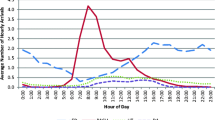Abstract
Non-linear processes within complex systems are difficult to predict. Using discrete event simulation (DES) models can be helpful for presenting the uncertainty level embedded within these processes. However, the interpretations of the resulting outcomes can be challenging to analyze. This is evident when experimenting with simulation models, and therefore requires the adaptation of existing models. Introducing cyclic entities such as interconnected resources to the simulation model adds a new level of complexity to the model. In practical cases, decision makers often demand a model that enables them to make quick decisions with less complexity involved. However, these individuals still want to be assured of a high degree of accuracy in the results. This article demonstrates how an analytical representation of complex DES models can be developed in order to facilitate prompt yet effective solutions for decision makers. This analytical representation provides a brief overview of the simulation results by using the staff scheduling and nurses’ utilization approaches. Results of the effective use of DES model and managers feedback are encouraging.








Similar content being viewed by others
References
Abo-Hamad W, Arisha A (2013) A simulation-based framework to improve patient experience in an emergency department. Eur J Oper Res 224(1):154–166
Banks J, Carson JS II, Nelson BL, Nicol DM (2005) Discrete-event system simulation, 4th edn. Prentice Hall international series in industrial and systems engineering. Pearson Prentice Hall, London
Brailsford S (2005) Overcoming the barriers to implementation of operations research simulation models in healthcare. Clin Investig Med 28(6):312–317 (2005). http://www.ncbi.nlm.nih.gov/pubmed/16450620
Friedman LW (1996) The simulation metamodel. Springer, US. doi:10.1007/978-1-4613-1299-4. ISBN:978-1-4612-8556-4
Glasserman P, Kou SG (1995) Analysis of an importance sampling estimator for tandem queues. ACM Trans Model Comput Simul 5:22–42. doi:10.1145/203091.203093
Harper P, Shahani A, Gallagher J, Bowie C (2005) Planning health services with explicit geographical considerations: a stochastic location approach. Omega 33(2):141–152. doi:10.1016/j.omega.2004.03.011. http://www.sciencedirect.com/science/article/pii/S0305048304000593
Harper PR, Powell NH, Williams JE (2009) Modelling the size and skill-mix of hospital nursing teams. J Oper Res Soc 61((2010)):768–779
Health Service Executive (HSE) (2007) Emergency department task force report. Technical report, Health Service Executive (HSE)
Isken MW, Ward TJ, McKee Timothy C (1999) Simulating outpatient obstetrical clinics. In: Farrington PA, Nemhard HB, Sturrock DT, Evans GW (eds) Proceedings of the 31st conference on winter simulation: simulation—a bridge to the future, vol 2. ACM, New York, pp 1557–1567
Ismail K, Thorwarth M, Arisha A (2014) Integrated decision support systems for improving emergency department performance in Irish hospitals. Int J Oper Res 19(1):40–59. doi:10.1504/IJOR.2014.057843. http://inderscience.metapress.com/content/E55376000172685U
Jacobson SH, Hall SN, Swisher JR (2006) Patient flow: reducing delay in healthcare delivery. Discrete Event Simul Health Care Syst 91:211–252
Law AM, Kelton WD (2000) Simulation modelling and analysis, 3rd reviewed, edition edn. McGraw-Hill Education, New York
Lowery JC (1996) Introduction to simulation in health care. In: Brunner DT, Swain JJ, Charnes JM, Morrice DJ (eds) Proceedings of the 28th conference on winter simulation. Coronado, California, pp 78–84
Pidd M (2012) Mixing other methods with simulation is no big deal. In: Simulation conference (WSC), Proceedings of the 2012 Winter, pp 1–7. doi:10.1109/WSC.2012.6465280
Poropudas J, Virtanen K (2011) Simulation metamodeling with dynamic bayesian networks. Eur J Oper Res 214(3):644–655. doi:10.1016/j.ejor.2011.05.007. http://www.sciencedirect.com/science/article/pii/S0377221711004127
Proudlove NC, Black S, Fletcher A (2007) OR and the challenge to improve the NHS: modelling for insight and improvement in in-patient flows. J Oper Res Soc 58:145–158
Ragab M, Rashwan W, Abo-Hamad W, Arisha A (2013) Using modelling and simulation to improve elderly care in Ireland: a case study. Int J Adv Life Sci 5(1 and 2):89–102
Richardson DB (2006) Increase in patient mortality at 10 days associated with emergency department overcrowding. Med J Aust 184(5):213–216
Stahl JE, Rattner D, Wiklund R, Lester J, Beinfeld M, Gazelle GS (2004) Reorganizing the system of care surrounding laparoscopic surgery: a cost-effectiveness analysis using discrete-event simulation. Med Decis Mak 24(5):461–471. doi:10.1177/0272989X04268951. http://mdm.sagepub.com/content/24/5/461.abstract
Thorwarth M (2011) A simulation-based decision support system to improve healthcare facilities performance elaborated on an Irish emergency department. Ph.D. thesis, Dublin Institute of Technology
Unruh L, Joseph L, Strickland M (2007) Nurse absenteeism and workload: negative effect on restraint use, incident reports and mortality. J Adv Nurs 60(9):673–681
Wierzbicki AP (2007) Modelling as a way of organising knowledge. Eur J Oper Res 176(1):610–635. doi:10.1016/j.ejor.2005.08.018. http://www.sciencedirect.com/science/article/pii/S0377221705007010
Author information
Authors and Affiliations
Corresponding author
Rights and permissions
About this article
Cite this article
Thorwarth, M., Rashwan, W. & Arisha, A. An analytical representation of flexible resource allocation in hospitals. Flex Serv Manuf J 28, 148–165 (2016). https://doi.org/10.1007/s10696-015-9216-4
Published:
Issue Date:
DOI: https://doi.org/10.1007/s10696-015-9216-4




